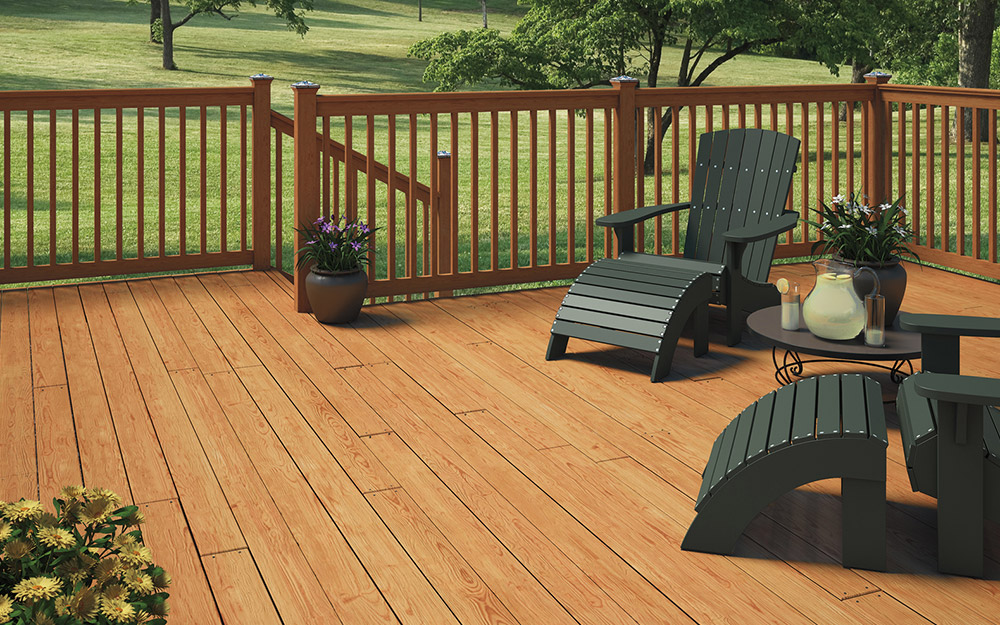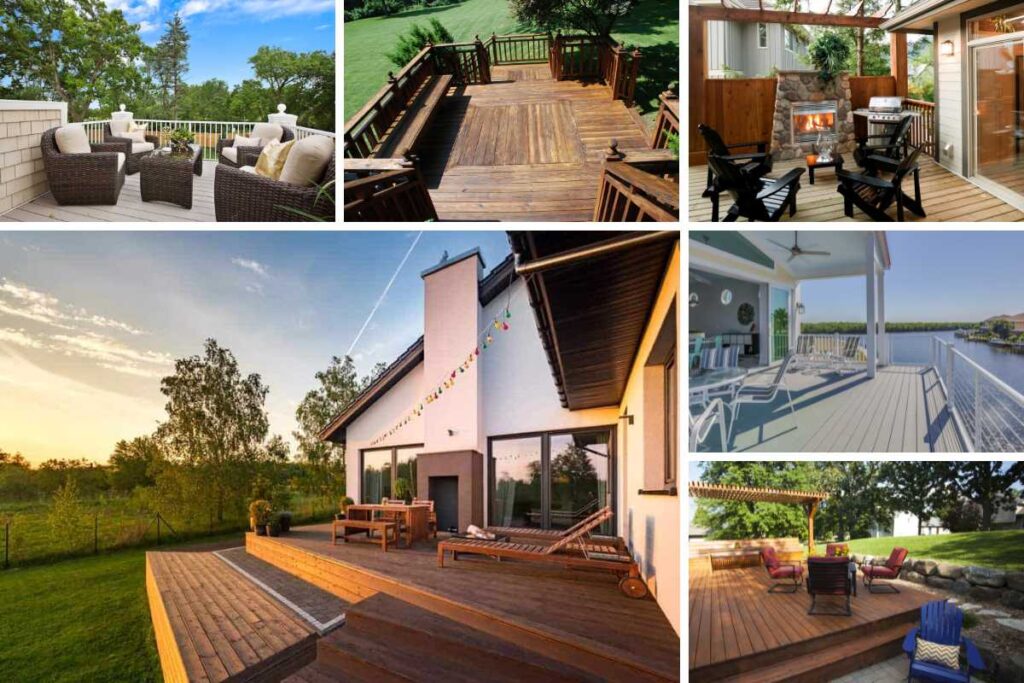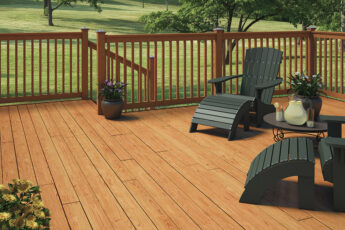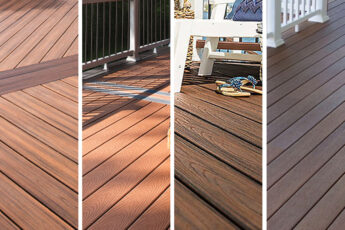
Welcome to our blog post on residential wood deck design! If you’re looking to enhance your outdoor living space and create a stunning extension of your home, then designing a wood deck is the perfect solution. A well-designed deck not only adds value to your property but also provides a beautiful area for relaxation, entertaining guests, or simply enjoying the great outdoors. In this article, we will explore the purpose and benefits of wood decks, factors to consider before designing one, different types of wood options available, design ideas for various house styles, essential features to include in your deck design, as well as maintenance tips for longevity. So let’s dive in and discover how you can transform your backyard into an inviting oasis with a carefully planned residential wood deck!
Understanding The Purpose And Benefits Of A Wood Deck

A wood deck serves multiple purposes and offers a plethora of benefits for homeowners. First and foremost, it provides an extension of your indoor living space to the outdoors, allowing you to enjoy nature without sacrificing comfort. Whether you want to relax with a book, host outdoor parties, or simply soak up some sunshine, a wood deck offers the perfect platform.
One of the key advantages of a wood deck is its versatility in design and functionality. You can customize it to suit your specific needs and style preferences. From incorporating built-in seating areas or fire pits to adding pergolas or trellises for shade and privacy, the possibilities are endless.
Furthermore, investing in a wood deck can significantly increase the value of your property. Potential buyers often see decks as desirable features that enhance curb appeal and offer additional usable space.
In terms of maintenance, properly treated and sealed wood decks can withstand various weather conditions while maintaining their beauty over time. Regular cleaning and sealing will help prolong the life of your deck.
When designed thoughtfully with consideration given to location, size, materials used, aesthetics, and functionality – a well-crafted residential wood deck becomes an inviting retreat that seamlessly blends with your home’s architecture while offering countless opportunities for relaxation and enjoyment outdoors.
Factors to Consider Before Designing Your Deck

A. Location And Size
Location and size are two crucial factors to consider when designing a residential wood deck. The location of your deck will determine the amount of sunlight it receives, its privacy level, and how it integrates with your existing outdoor space. It’s important to choose a spot that provides the right balance between sun and shade, while also considering any potential obstacles such as trees or structures.
In terms of size, you’ll need to assess how much space you have available and how you plan on using your deck. Will it primarily serve as an area for lounging and entertaining guests? Or do you envision it as an extension of your living space where you can dine al fresco? Determining the purpose of your deck will help dictate its size.
Additionally, consider any local building codes or regulations that may impact the location and size of your deck. These guidelines are in place to ensure safety and compliance with zoning laws.
By carefully considering the location and size of your wood deck, you can create a functional outdoor space that seamlessly blends with the rest of your home.
B. Budget
When it comes to designing a residential wood deck, one of the key factors that homeowners need to consider is their budget. Setting a realistic budget from the beginning can help you make informed decisions and avoid any financial surprises along the way.
The cost of building a wood deck can vary greatly depending on several factors. First, consider the size and complexity of your desired design. A larger deck with intricate features will naturally require more materials and labor, which can drive up costs. Additionally, the choice of materials will also impact your budget. While natural hardwoods may be more expensive upfront, they often offer greater durability and longevity compared to composite or pressure-treated options.
It’s important to strike a balance between your dream deck and what you can afford. Consider prioritizing essential elements first and leave room for potential upgrades in the future when finances allow. Researching different suppliers and contractors can also help you find competitive pricing without compromising quality.
Remember that building a wood deck is an investment in your home’s value and enjoyment for years to come. By carefully considering your budget at the outset, you’ll be well on your way to creating a beautiful outdoor space that fits both your lifestyle and financial goals!
C. Materials
When it comes to designing a residential wood deck, choosing the right materials is crucial. The materials you select will not only impact the overall look and feel of your deck but also its durability and longevity.
One popular option for decking material is pressure-treated wood. This type of wood is treated with chemicals to resist rot, decay, and insect damage. It’s an affordable choice that can withstand harsh weather conditions, making it ideal for outdoor use.
Another option to consider is cedar or redwood. These woods are naturally resistant to rot and insects without the need for chemical treatment. They have a beautiful natural color and grain pattern that adds warmth and character to any deck design.
For those looking for a more eco-friendly option, composite decking may be worth considering. Made from a combination of recycled plastic and wood fibers, composite decking offers the look of real wood without the maintenance requirements. It’s durable, fade-resistant, and available in a wide range of colors.
If you prefer a luxurious aesthetic, hardwoods such as ipe or mahogany are excellent choices. These woods are known for their exceptional strength and durability. While they require regular maintenance to preserve their beauty over time, they can provide a stunning backdrop for any outdoor space.
When selecting materials for your residential wood deck design, consider factors such as budgetary constraints, desired aesthetics, required maintenance level,and sustainability concerns
D. Aesthetic And Functionality
When designing a wood deck for your residential space, it’s important to consider both the aesthetic appeal and functionality of the structure. The design should seamlessly blend with the overall style of your home while also providing practical features that enhance its usability.
Aesthetically, you’ll want to choose a deck design that complements the architecture and landscaping of your property. Consider factors such as color, texture, and pattern when selecting materials for your deck. For example, if you have a traditional-style home with brick or stone accents, a wood deck with warm tones and natural grain patterns can create a cohesive look.
Functionality is equally important in creating an enjoyable outdoor space. Think about how you plan to use your deck – will it be primarily for entertaining guests or as a private retreat? This will help determine the layout and size of your deck as well as any additional features like seating areas, built-in planters, or overhead structures for shade.
Incorporating functional elements into the design can greatly enhance the usability of your deck. For instance, adding lighting fixtures allows you to enjoy evenings on the deck without relying solely on ambient light from inside your home. Built-in storage options provide convenient places to store outdoor furniture cushions or gardening tools.
By carefully considering both aesthetic appeal and functionality when designing your wood deck, you can create an outdoor living space that not only looks great but also meets all of your needs!
Different Types Of Wood For Decks

When it comes to building a wood deck, choosing the right type of wood is crucial. The choice of wood will not only affect the overall aesthetic appeal of your deck but also its durability and maintenance requirements.
One popular option for decking material is pressure-treated lumber. This type of wood has been chemically treated to resist rot, decay, and insect infestation. It is an affordable and readily available option that can last for many years with proper care.
Cedar is another excellent choice for residential decks. Known for its natural beauty and resistance to rot and insects, cedar offers a warm and inviting look to any outdoor space. It does require regular maintenance such as staining or sealing to maintain its appearance.
For those looking for a more exotic look, tropical hardwoods like ipe or teak are worth considering. These woods are incredibly durable and naturally resistant to rot, decay, and pests. However, they do come at a higher price point compared to other options.
If sustainability is important to you, consider using composite decking made from recycled materials like plastic or sawdust mixed with resin binders. Composite decking mimics the appearance of natural wood while requiring minimal maintenance.
With so many options available in terms of types of wood for decks, it’s essential to weigh factors such as cost, aesthetics, durability, and environmental impact before making your decision.
Design Ideas For Various House Styles

When it comes to designing a wood deck for your residential property, it’s important to consider the style and architecture of your home. The design of your deck should complement and enhance the overall aesthetic appeal of your house. Here are some design ideas for different house styles:
1. Traditional Style: For homes with traditional architecture, opt for a classic deck design using natural wood materials such as cedar or redwood. Incorporate ornamental details like balusters and railings to create an elegant and timeless look.
2. Modern Style: If you have a contemporary or modern-style home, go for a sleek and minimalist deck design. Consider using composite decking materials in neutral colors like gray or black, paired with stainless steel cable railings for a clean and sophisticated look.
3. Craftsman Style: Homes with craftsman-style architecture can benefit from a warm and inviting deck design that showcases the beauty of natural wood grain. Use rich-toned woods like mahogany or ipe to create a cozy outdoor living space.
4. Mediterranean Style: Mediterranean-style homes call for decks that exude warmth and charm. Opt for terracotta-colored tiles on the flooring, complemented by wrought iron accents on railings or pergolas, creating an outdoor oasis reminiscent of Mediterranean villas.
Remember, these are just starting points; feel free to mix elements from different styles to achieve the desired look that complements your unique vision! By considering the architectural style of your home when designing your wood deck, you can create a harmonious connection between indoor and outdoor spaces while showcasing your personal taste.
Essential Features To Include In Your Deck Design
When designing your wood deck, there are several essential features that you should consider incorporating to enhance its functionality and aesthetic appeal.
The layout of your deck is crucial. Consider including multiple levels or tiers to create distinct areas for dining, lounging, and entertaining. This will maximize the space available and provide different options for outdoor activities.
Think about adding built-in seating such as benches or corner sofas. Not only does this save space compared to bulky furniture, but it also adds a stylish touch while providing ample seating for guests.
Incorporating shade elements into your deck design is another important consideration. Install a pergola or awning to protect against harsh sun rays during summer months while still allowing some natural light in.
To extend the use of your deck into the evening hours, include adequate lighting fixtures such as string lights or recessed lighting along stairs and pathways. This will not only ensure safety but also create a cozy ambiance for nighttime gatherings.
Don’t forget about storage solutions! Built-in storage benches or cabinets can be used to store cushions, gardening tools, or other outdoor equipment neatly out of sight.
By considering these essential features when designing your wood deck, you can create a functional and inviting outdoor space that suits your needs and enhances the overall appeal of your home.
Maintenance And Longevity Of A Wood Deck
One of the key factors to consider when designing a residential wood deck is its maintenance and longevity. Proper care and upkeep are essential to ensure that your deck remains in good condition for years to come.
Regular maintenance tasks include cleaning the deck surface, removing debris, and applying a protective sealant or stain. This helps prevent moisture damage and extends the lifespan of the wood. It’s important to follow manufacturer recommendations for cleaning products and application methods.
Inspecting your deck regularly is also crucial. Look out for signs of rot, decay, or insect infestation. Promptly address any issues by replacing damaged boards or treating affected areas.
In addition to regular maintenance, choosing durable materials can contribute to the longevity of your wood deck. Hardwood species such as cedar or redwood are known for their natural resistance to rot and decay. Alternatively, treated lumber can provide added protection against insects and moisture.
Taking these steps will not only prolong the life of your wood deck but also enhance its aesthetic appeal. With proper care and attention, you can enjoy many years of outdoor living on your beautiful residential wood deck!
Conclusion
In this article, we have explored the world of residential wood deck design and all its facets. From understanding the purpose and benefits of a wood deck to considering various factors before designing one, we have covered it all.
A well-designed wood deck can not only enhance the aesthetic appeal of your home but also provide a functional outdoor living space for relaxation and entertainment. It is essential to carefully plan the location, size, budget, materials, and overall functionality of your deck to ensure it meets your needs and preferences.
When it comes to choosing the right type of wood for your deck, there are several options available. Each type has its own unique characteristics in terms of durability, appearance, and maintenance requirements. By selecting the appropriate wood species for your specific climate conditions and desired look, you can create a stunning outdoor retreat that stands the test of time.
Additionally, different house styles call for different deck designs. Whether you have a traditional farmhouse or a modern contemporary home, there are numerous design ideas that can complement your architectural style seamlessly. Incorporating essential features like seating areas, lighting fixtures, pergolas or awnings will further enhance both the beauty and functionality of your wooden deck.
Maintaining your wood deck properly is crucial for its longevity. Regular cleaning and sealing are necessary to protect against weather damage such as rotting or warping caused by moisture exposure. With proper care and periodic inspections for any signs of wear or damage over time,your residential wood deck will continue to be an inviting haven that adds value to your property.
In conclusion (without using “in conclusion”), designing a residential wood deck requires careful thought along with creativity.
The perfect balance between aesthetics,functionality,and long-term durability should be achieved.
With endless possibilities in terms of design,options with different typesofwoodandfeatures,it’s importantto consideryour specific needs,budget,restrictionsofthehouse style,andmaintenance requirements.



